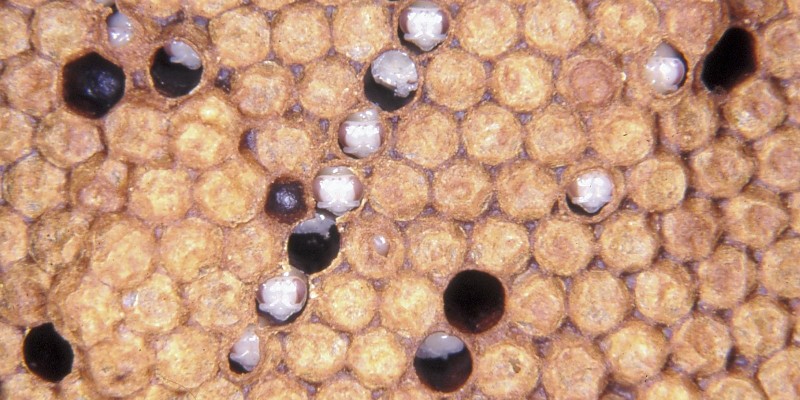Honeybee Diseases - Bald Brood
Bald Brood - is a condition where normal looking live pupae are visible through incompletely capped cells. Normally developing pupae are usually sealed in their cells under wax cappings 8-9 days after laying. The most usual cause of bald brood is wax moth both the lesser and greater - Achroia grisella and Galleria mellonella larvae tunnelling below the surface of the comb. The larvae will perforate the cappings, which are then chewed down by the worker bees; sometimes these partial cappings have a raised lip protruding from the comb surface. These uncapped larvae will usually emerge as fully developed adults, although a few malformed adults may result from contaminants becoming deposited on the developing larvae. Another cause of bald brood is genetic, where the worker bees do not cap the cells properly, either turning the cell edges inward or leaving a small hole in the centre of the capping.
Please download the Bald Brood Info Sheet to obtain a printable version of Bald Brood information, detection and treatment methods for your records.
Recognition
Image Courtesy The Animal and Plant Health Agency (APHA), © Crown Copyright

The partial capping on cells suffering from Bald Brood have raised lips that protrude from the comb. Wax Moth Larvae may be present on inspection.
Detection
Hive Examination - Careful examination of the hive, be on the look out for and pests such as the wax moth which is a main cause of this condition. Abnormalities of the brood nest and combs are generally easily spotted.
Monitoring - Vigilance is important with all honeybee diseases. Check all apiaries and colonies regularly for health and suspect any colonies that are not thriving where there is no already known reason. Colonies that die out should be examined thoroughly and sealed to prevent robbing and spread of any disease present.
Treatment
Note: Presently there is no effective medical treatments for Bald Brood. Bald Brood is a condition where normal looking live pupae are visible through incompletely capped cells. Normally developing pupae are usually sealed in their cells under wax cappings 8-9 days after laying. There is no specific treatment recommended for Bald Brood however treating for Wax Moth will aid the prevention of Bald Brood. Prevention is the best method of controlling this condition by maintaining healthy, strong and vigorous colonies that display good hygienic traits. Good husbandry contributes greatly to overall colony behaviour and health, thereby avoiding the conditions in which Bald Brood can develop. Colonies that suffer excessively from Bald Brood may need to be re-queened, the combs destroyed and hive components disinfected before re-use. Further information can be obtained from BeeBase.
- Always maintain strong productive colonies
- Always maintain a high level of hygiene in all your beekeeping practices
- Carry out methodical health inspections on a regular basis, checking for brood disease particularly in spring and autumn.
- Never transfer combs between colonies without checking for brood diseases
- Systematically replace old brood combs in your hives melting down the old comb to maintain clean and healthy brood.
- Never bring colonies or equipment into your apiary without establishing their origin, condition, and disease status.
- Sterilise any secondhand equipment or hive components before introducing them into your apiary
- Discourage drifting and robbing in the apiary
- Suspect stray swarm health until you know otherwise
- Report any incidence of disease or suspicious conditions immediately to your local association
Vectors
Beekeepers - Transferring contaminated equipment / material between hives, swarms, colonies and apiary sites.
About the 'My Beekeeping Kit' website.
Contact Iain Dewar for enquiries, suggestions, corrections and contributions for improving the notes. Always welcome!